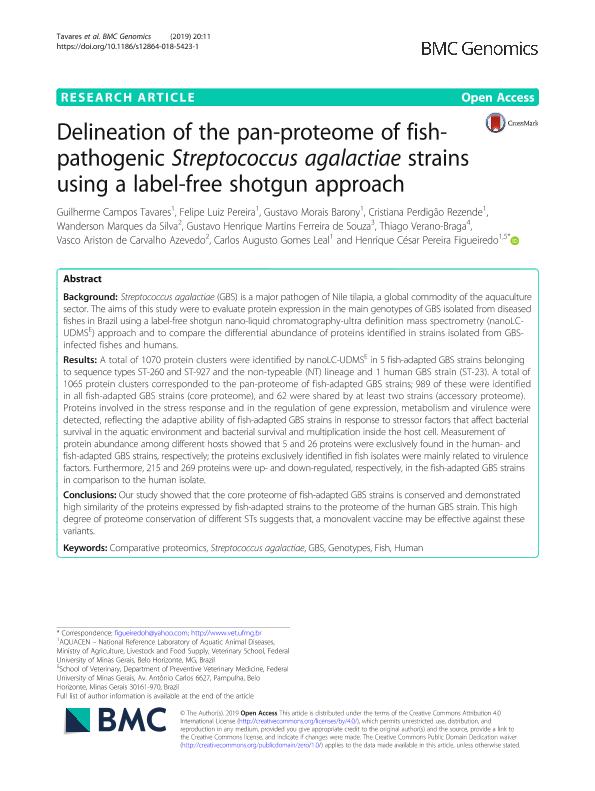Mostrar el registro sencillo del ítem
dc.contributor.author
Tavares Campos, Guilherme
dc.contributor.author
Pereira, Felipe Luiz
dc.contributor.author
Morais Barony, Gustavo
dc.contributor.author
Perdigão Rezende, Cristiana
dc.contributor.author
Marques Da Silva, Wanderson

dc.contributor.author
Martins Ferreira de Souza, Gustavo Henrique
dc.contributor.author
Verano Braga, Thiago
dc.contributor.author
De Carvalho Azevedo, Vasco Ariston
dc.contributor.author
Gomes Leal, Carlos Augusto
dc.contributor.author
Pereira Figueiredo, Henrique César
dc.date.available
2021-12-20T11:31:35Z
dc.date.issued
2019-01-07
dc.identifier.citation
Tavares Campos, Guilherme; Pereira, Felipe Luiz; Morais Barony, Gustavo; Perdigão Rezende, Cristiana; Marques Da Silva, Wanderson; et al.; Delineation of the pan-proteome of fish-pathogenic Streptococcus agalactiae strains using a label-free shotgun approach; BioMed Central; BMC Genomics; 20; 1; 7-1-2019; 1-22
dc.identifier.issn
1471-2164
dc.identifier.uri
http://hdl.handle.net/11336/149004
dc.description.abstract
Background: Streptococcus agalactiae (GBS) is a major pathogen of Nile tilapia, a global commodity of the aquaculture sector. The aims of this study were to evaluate protein expression in the main genotypes of GBS isolated from diseased fishes in Brazil using a label-free shotgun nano-liquid chromatography-ultra definition mass spectrometry (nanoLC-UDMS E ) approach and to compare the differential abundance of proteins identified in strains isolated from GBS-infected fishes and humans. Results: A total of 1070 protein clusters were identified by nanoLC-UDMS E in 5 fish-adapted GBS strains belonging to sequence types ST-260 and ST-927 and the non-typeable (NT) lineage and 1 human GBS strain (ST-23). A total of 1065 protein clusters corresponded to the pan-proteome of fish-adapted GBS strains; 989 of these were identified in all fish-adapted GBS strains (core proteome), and 62 were shared by at least two strains (accessory proteome). Proteins involved in the stress response and in the regulation of gene expression, metabolism and virulence were detected, reflecting the adaptive ability of fish-adapted GBS strains in response to stressor factors that affect bacterial survival in the aquatic environment and bacterial survival and multiplication inside the host cell. Measurement of protein abundance among different hosts showed that 5 and 26 proteins were exclusively found in the human- and fish-adapted GBS strains, respectively; the proteins exclusively identified in fish isolates were mainly related to virulence factors. Furthermore, 215 and 269 proteins were up- and down-regulated, respectively, in the fish-adapted GBS strains in comparison to the human isolate. Conclusions: Our study showed that the core proteome of fish-adapted GBS strains is conserved and demonstrated high similarity of the proteins expressed by fish-adapted strains to the proteome of the human GBS strain. This high degree of proteome conservation of different STs suggests that, a monovalent vaccine may be effective against these variants.
dc.format
application/pdf
dc.language.iso
eng
dc.publisher
BioMed Central

dc.rights
info:eu-repo/semantics/openAccess
dc.rights.uri
https://creativecommons.org/licenses/by/2.5/ar/
dc.subject
COMPARATIVE PROTEOMICS
dc.subject
FISH
dc.subject
GBS
dc.subject
GENOTYPES
dc.subject
HUMAN
dc.subject
STREPTOCOCCUS AGALACTIAE
dc.subject.classification
Biología Celular, Microbiología

dc.subject.classification
Ciencias Biológicas

dc.subject.classification
CIENCIAS NATURALES Y EXACTAS

dc.title
Delineation of the pan-proteome of fish-pathogenic Streptococcus agalactiae strains using a label-free shotgun approach
dc.type
info:eu-repo/semantics/article
dc.type
info:ar-repo/semantics/artículo
dc.type
info:eu-repo/semantics/publishedVersion
dc.date.updated
2020-10-29T20:03:24Z
dc.journal.volume
20
dc.journal.number
1
dc.journal.pagination
1-22
dc.journal.pais
Reino Unido

dc.journal.ciudad
Londres
dc.description.fil
Fil: Tavares Campos, Guilherme. Universidade Federal de Minas Gerais; Brasil
dc.description.fil
Fil: Pereira, Felipe Luiz. Universidade Federal de Minas Gerais; Brasil
dc.description.fil
Fil: Morais Barony, Gustavo. Universidade Federal de Minas Gerais; Brasil
dc.description.fil
Fil: Perdigão Rezende, Cristiana. Universidade Federal de Minas Gerais; Brasil
dc.description.fil
Fil: Marques Da Silva, Wanderson. Universidade Federal de Minas Gerais; Brasil. Instituto Nacional de Tecnología Agropecuaria. Centro de Investigación en Ciencias Veterinarias y Agronómicas. Instituto de Agrobiotecnología y Biología Molecular. Consejo Nacional de Investigaciones Científicas y Técnicas. Oficina de Coordinación Administrativa Parque Centenario. Instituto de Agrobiotecnología y Biología Molecular; Argentina
dc.description.fil
Fil: Martins Ferreira de Souza, Gustavo Henrique. No especifíca;
dc.description.fil
Fil: Verano Braga, Thiago. Universidade Federal de Minas Gerais; Brasil
dc.description.fil
Fil: De Carvalho Azevedo, Vasco Ariston. Universidade Federal de Minas Gerais; Brasil
dc.description.fil
Fil: Gomes Leal, Carlos Augusto. Universidade Federal de Minas Gerais; Brasil
dc.description.fil
Fil: Pereira Figueiredo, Henrique César. Universidade Federal de Minas Gerais; Brasil
dc.journal.title
BMC Genomics

dc.relation.alternativeid
info:eu-repo/semantics/altIdentifier/url/https://bmcgenomics.biomedcentral.com/articles/10.1186/s12864-018-5423-1
dc.relation.alternativeid
info:eu-repo/semantics/altIdentifier/doi/http://dx.doi.org/10.1186/s12864-018-5423-1
Archivos asociados
